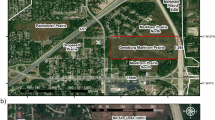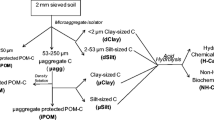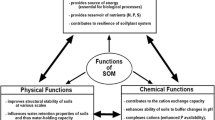Abstract
Concentrations of particulate and total organic matter were measured in upper soil profiles at 26 sites as a potential means to identify toxic damage to soil ecosystems. Because soil organic matter plays a role in cycling nutrients, aerating soil, retaining water, and maintaining tilth, a significant reduction in organic matter content in a soil profile is not just evidence of a change in ecosystem function, but of damage to that soil ecosystem. Reference sites were selected for comparison to contaminated sites, and additional sites were selected to illustrate how variables other than environmental contaminants might affect the soil organic matter profile. The survey was undertaken on the supposition that environmental contaminants and other stressors reduce the activity of earthworms and other macrofauna, inhibiting the incorporation of organic matter into the soil profile. The profiles of the unstressed soils showed a continuous decrease in organic matter content from the uppermost mineral soil layer (0–2.5 cm) down to 15 cm. Stressed soils showed an abrupt decrease in soil organic matter content below a depth of 2.5 cm. The 2.5–5.0 cm layer of stressed soils–such as found in a pine barren, an orchard, sites contaminated with zinc, and a site with compacted soil–had less than 4 % total organic matter and less than 1 % particulate organic matter. However, damaged soil ecosystems were best identified by comparison of their profiles to the profiles of closely matched reference soils, rather than by comparison to these absolute values. The presence or absence of earthworms offered a partial explanation of observed differences in soil organic matter profiles.
Similar content being viewed by others
References
Baker, W.L. (1946). DDT and earthworm populations. J. Econ. Entomol. 39, 404–5.
Bembridge, J., Kedwards, T.J. and Edwards. P.J. (1998). Variation in earthworm populations and methods for assessing responses to perturbations. In S.C. Sheppard, J.D. Bembridge. M. Holmstrup and L. Posthuma (eds) Advances in Earthworm Ecotoxicology, Proceedings of the Second International Workshop on Earthworm Ecotoxicology, Amsterdam, 1997, pp. 341–52. Pensacola, FL: SETAC Press.
Berg, B., Ekbohm, G., Soderstrom, B. and Staaf, H. (1991). Reduction of decomposition rates of Scots pine needle litter due to heavy-metal pollution. Water Air Soil Pollut. 59, 165–77.
Beyer, W.N. and Linder, G. (1995). Making sense of soil ecotoxicology. In D.J. Hoffman, B.A. Rattner, G.A. Burton, Jr. and J. Cairns, Jr. (eds) Handbook of Ecotoxicology, pp. 104–16. Boca Raton, FL: Lewis Publishers.
Beyer, W.N., Miller, G.W. and Cromartie, E.J. (1984). Contamination of the O2 soil horizon by zinc smelting and its effect on woodlouse survival. J. Environ. Qual. 13, 247–51.
Beyer, W.N. and Storm, G. (1995). Ecotoxicological damage from zinc smelting at Palmerton, Pennsylvania. In D.J. Hoffman, B.A. Rattner, G.A. Burton, Jr. and J. Cairns, Jr. (eds) Handbook of Ecotoxicology, pp. 509–608. Boca Raton, FL: Lewis Publishers.
Blair, J.M., Bohlen, P.J. and Freckman, D.W. (1996). Soil invertebrates as indicators of soil quality. In J.W. Doran and A.J. Jones (eds) Methods for Assessing Soil Quality, SSSA Special Publication 49, pp. 273–91. Madison, WI: Soil Science Society of America.
Braun, E.L. (1950). Deciduous Forests of Eastern North America. Philadelphia, PA: The Blackiston Co.
Buchauer, M.J. (1973). Contamination of soil and vegetation near a zinc smelter by zinc, cadmium, copper, and lead. Environ. Sci. Technol. 7, 131–5.
Cambardella, C.A. and Elliott, E.T. (1992). Particulate soil organicmatter changes across a grassland cultivation sequence. Soil Sci. Soc. Am. J. 56, 777–83.
Clements, R.O., Murray, P.J. and Sturdy R.G. (1991). The impact of 20 years' absence of earthworms and three levels of N fertilizer on a grassland soil environment. Agric. Ecosyst. & Environ. 36, 75–85.
Cook, M.E. and Swait, A.A. (1975). Effects of some fungicide treatments on earthworm populations and leaf removal in apple orchards. J. Hortic. Sci. 50, 495–9.
Coughtrey, P.J., Jones, C.H., Martin, M.H. and Shales, S.W. (1979). Litter accumulation in woodlands contaminated by Pb, Zn, Cd and Cu. Oecologia (Berl.) 39, 51–60.
Dindal, D.L. (1977). Influence of human activities on oribatid mite communities. In D.L. Dindal (ed) Biology of Oribatid Mites, pp. 105–22. Syracuse, NY: State University of New York.
Doran, J.W., Jones, A.J., Arshad, M.A. and Gilley, J.E. (1996). Determinants of soil quality and health. In R. Lal (ed) Soil Quality and Soil Erosion, pp. 17–36. Boca Raton, FL: Soil and Water Conservation Society, CRC Press.
Doube, B.M. and Schmidt, O. (1997). Can the abundance or activity of soil macrofauna be used to indicate the biological health of soils? In C. Pankhurst, B.M. Doube and V.V.S.R. Gupta (eds) Biological Indicators of Soil Health, pp. 265–95. Wallingford: CAB International.
Edwards, C.A. (1981). Earthworms, soil fertility and plant growth. In M. Appelhof (ed) Workshop on the Role of Earthworms in the Stabilization of Organic Residues,Vol. 1, pp. 61–85. Kalamazoo, MI: Beech Leaf Press.
Edwards, C.A. and Lofty, J.R. (1978). The influence of arthropods and earthworms upon root growth of direct drilled cereals. J. Appl. Ecol. 15, 789–95.
Edwards, C.A. and Lofty, J.R. (1980). Effects of earthworm inoculation upon root growth of direct drilled cereals. J. Appl. Ecol. 17, 533–43.
Freedman, B, and Hutchinson, T.C. (1980). Smelter pollution near Sudbury, Ontario, Canada, and effects on forest litter decomposition. In T.C. Hutchinson and M. Havas (eds) Effects of Acid Precipitation on Terrestrial Ecosystems, pp. 395–434. NewYork, NY: Plenum Press.
Gregorich, E.G. and Janzen, H.H. (1996). Storage of soil carbon in the light fraction and macroorganic matter. In M.R. Carter and B.A. Stewart (eds) Structure and Organic Matter Storage in Agricultural Soils, pp. 167–90. Boca Raton, FL: Lewis Publishers.
Guild, W.J.M. (1955). Earthworms and soil structure. In D.K. McE. Kevan (ed) Soil Zoology, Proceedings of the University of Nottingham Second Easter School in Agricultural Science, pp.83–98. London: Butterworths Publications Ltd.
Heal, O.W. and Dighton, J. (1985). Resource quality and trophic structure in the soil system. In A.H. Fitter (ed) Ecological Interactions in Soil, pp. 339–54. Oxford: Blackwell Scientific Publications.
Hirst, J.M., Le Riche, H.H. and Bascomb, C.E. (1961). Copper accumulation in the soils of apple orchards near Wisbech. Plant Pathol. 10, 105–8.
Hutton, M. (1984). Impact of airborne metal contamination on a deciduous woodland system. In P.J. Sheehan. D.R. Miller and G.C. Butler (eds) Effects of Pollutants at the Ecosystem Level, pp. 365–75. New York, NY: John Wiley.
Isaac, R.A. and Johnson, W.C. (1983). High speed analysis of agricultural samples using inductively coupled plasma-atomic emission spectroscopy. Spectrochem. Acta 38B, 277–82.
Jacks, G.V. (1963). The biological nature of soil productivity. Soils and Fertilizers 26, 147–50.
Jenny H. (1980). The Soil Resource. Ecological Studies, Vol. 37. New York, NY: Springer-Verlag.
Jordan, M.J. and Lechevalier, M.P. (1975). Effects of zinc-smelter emissions on forest soil microflora. Can. J. Microbiol. 21, 1855–65.
Kelsey, J.M. and Arlidge, E.Z. (1968). Effects of isobenzan on soil fauna and soil structure. New Zealand J. Agric. Res. 11, 245–60.
Keogh, R.G. and Whitehead, P.H. (1975). Observations on some effects of pasture spraying with benomyl and carbendazim on earthworm activity and litter removal from pasture. New Zealand J. Exp. Agric. 3, 103–4.
Kevan, D.K. McE. (1968). Soil Animals. London: H.F.&G. Witherby, Ltd.
Kirby, R.M. and Matthews, E.D. (1973). Soil Survey of Anne Arundel County, Maryland. USDA, Soil Conservation Service, Washington, DC: U.S. Gov. Print. Office.
Kirby, R.M., Matthews, E.D. and Bailey, M.A. (1967). Soil Survey of Prince Georges County, Maryland. USDA, Soil Conservation Service, Washington, DC: U.S. Gov. Print. Office.
Kuhnelt, W. (1976). Soil Biology, 2nd edn. East Lansing, MI: Michigan State University Press.
Lee, K.E. (1985). Earthworms, their Ecology and Relationship with Soils and Land Use. Orlando, FL: Academic Press Inc.
Linden, D.R., Hendrix, P.F., Coleman, D.C. and van Vliet, P.C.J. (1994). Faunal indicators of soil quality. In J.W. Doran, D.C. Coleman, D.F. Bezdicek and B.A. Stewart (eds) Defining Soil Quality for a Sustainable Environment, SSSA Special Publication, pp. 91–106. Madison, WI: Soil Science Society of America.
Paul, E.A. and Collins, H.P. (1997). The characteristics of soil organic matter relative to nutrient cycling. In R. Lal, W.H. Blum, C. Valentine and B.A. Stewart (eds) Methods for Assessment of Soil Degradation. Advances in Soil Science, pp. 181–97. Boca Raton, FL: CRC Press.
Perkins, H.F. (1970). A rapid method of evaluating the zinc status of coastal plain soils. Commun. Soil Sci. Plant Anal. 1, 35–46.
Potter, D.A., Powell, A.J. and Smith, M.S. (1990). Degradation of turfgrass thatch by earthworms (Oligochaeta: Lumbricidae) and other soil invertebrates. J. Econ. Entomol. 83, 205–11.
Pugh, G.J.F. and Williams, J.I. (1971). Effect of an organo-mercury fungicide on saprophytic rungi and on litter decomposition. Trans. Br. Mycol. Soc. 57, 164–6.
Reybold, W.U., III and Matthews, E.D. (1976). Soil Survey of Baltimore County, Maryland. USDA, Soil Conservation Service. Washington, DC: U.S. Gov. Print. Office.
Romell, L.G. (1932). Mull and duff as biotic equilibria. Soil Sci. 34, 161–88.
Russell, D.J. and Alberti, G. (1998). Effects of long-term geogenic heavy metal contamination on soil organic matter and microarthropod communities, in particular Collembola. Appl. Soil Ecol. 9, 483–8.
Satchell, J.E. and Lowe, D.G. (1967). Selection of leaf litter by Lumbricus terrestris. In O. Graff and J.E. Satchell (eds) Progress in Soil Biology, pp. 102–19. Amsterdam: North Holland Publishing Co.
Scheu, S. (1987). Microbial activity and nutrient dynamics in earthworm casts (Lumbricidae). Biol. Fertil. Soils 5, 230–4.
Schulte, E.E. and B.G. Hopkins. (1996). Estimation of soil organic matter by weight loss-on ignition. In F.R. Magdoff, M.A. Tabatabai and E.A. Hanlon, Jr. (eds) Soil Organic Matter: Analysis and Interpretation, SSSA Special Publication 46, pp. 21–31. Madison, WI: Soil Science Society of America.
Sikora, L.J. and Stott, D.E. (1996). Soil organic carbon and nitrogen. In J.W. Doran and A.J. Jones (eds) Methods for Assessing Soil Quality, SSSA Special Publication 49, pp. 157–67. Madison, WI: Soil Science Society of America.
Strojan, C.L. (1978a). Forest leaf litter decomposition in the vicinity of a zinc smelter. Oecologia (Berl.) 32, 203–12.
Strojan, C.L. (1978b). The impact of zinc smelter emissions on forest litter arthropods. Oikos 31, 41–6.
Turgeon, A.J., Freeborg, R.P. and Bruce, W.N. (1975). Thatch development and other effects of preemergence herbicides inKentucky Bluegrass turf. Agron. J. 67, 563–5.
Tyler, G. (1972). Heavy metals pollute nature, may reduce productivity. Ambio 1, 52–9.
Tyler, G. (1977). Effect of heavy metal pollution on decomposition and mineralization rates in forest soils. In T.C. Hutchinson (ed) International Conference on Heavy Metals in the Environment, University of Toronto, Oct. 27–31, 1975, Symposium Proceedings, Vol. II, Part 1. pp. 217–26. Toronto, Canada: Electric Power Research Institute.
van Rhee, J.A. (1963). Earthworm activities and the breakdown of organic matter in agricultural soils. In J. Doeksen and J. van der Drift (eds) Soil Organisms, pp. 55–9. Amsterdam: North-Holland Pub. Co.
van Rhee, J.A. (1977).Astudy of the effect of earthworms on orchard productivity. Pedobiologia 17, 107–14.
Van deWesteringh, W. (1972). Deterioration of soil structure inworm free orchard soils. Pedobiologia 12, 6–15.
Vimmerstedt, J.P. and Finney, J.H. (1973). Impact of earthworm introduction on litter burial and nutrient distribution in Ohio strip-mine spoil banks. Soil Sci. Soc. Am. J. 37, 388–91.
Weary, G.C. and Merriam, H.G. (1978). Litter decomposition in a red maplewoodlot under natural conditions and under insecticide treatment. Ecology 59, 180–4.
West, L.T., Hendrix, P.F. and Bruce, R.R. (1991). Micromorphic observation of soil alteration by earthworms. Agric. Ecosyst. & Environ. 34, 363–70.
Author information
Authors and Affiliations
Corresponding author
Rights and permissions
About this article
Cite this article
Nelson Beyer, W. Estimating Toxic Damage to Soil Ecosystems from Soil Organic Matter Profiles. Ecotoxicology 10, 273–283 (2001). https://doi.org/10.1023/A:1016707200900
Issue Date:
DOI: https://doi.org/10.1023/A:1016707200900




